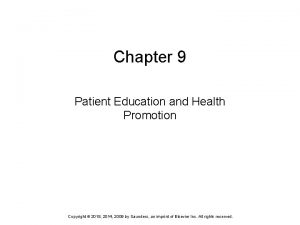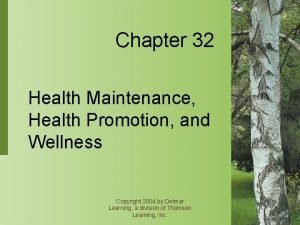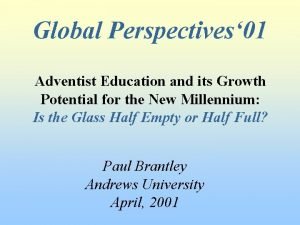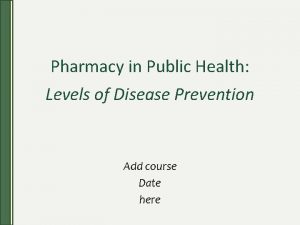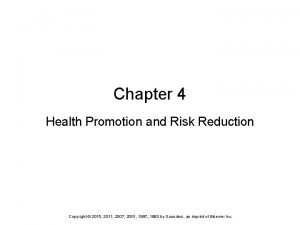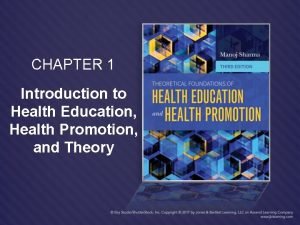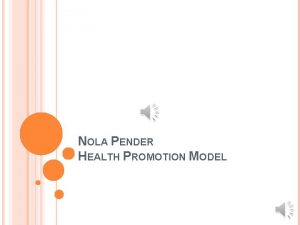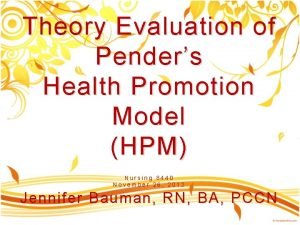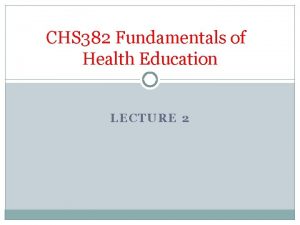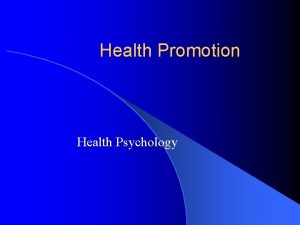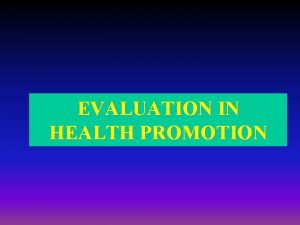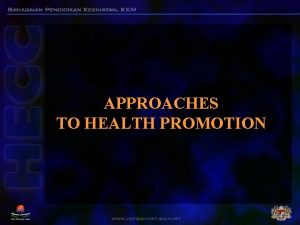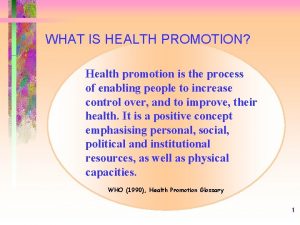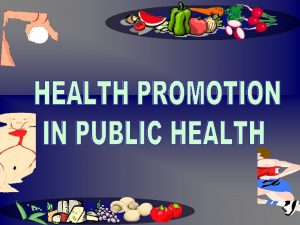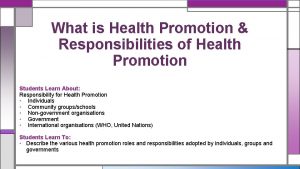Introduction to Health Education and Health Promotion Health


















- Slides: 18

Introduction to Health Education and Health Promotion

Health • “Health is the state of complete mental, physical, and social well being not merely the absence of disease or infirmity” (WHO, 2015) • Health should not be the goal of life, but rather a vehicle for reaching one’s goals in life

Health • Health is a dynamic state or condition of the human organism that is multidimensional in nature, a resource for living, and results from a person’s with an adaption to his or her environment • • • physical health emotional health social health intellectual spiritual health occupational

An approach to health that focuses on balancing the many aspects or dimensions, of a person’s life through increasing the adoption of health enhancing conditions and behaviors rather than attempting to minimize conditions of illness.

• always a positive quality (as opposed to illness being negative) is visualized as the integration of the spiritual, intellectual, physical, emotional, environmental, & social dimensions of health to form a whole “healthy person. ”

Wellness

Health Education • A combination of planned learning experiences based on sound theories that provide individuals, groups, and communities the opportunity to acquire information and the skills needed to make quality health decisions (Joint Committee, 2001, p. 247)

Health Education • A significant aspect of the role of healthcare provide is the education of others • A health care provider cannot be without health education • H. Edu is part of the scope and standards of nursing practice • is an important tool in health promotion and illness prevention

Health Education • A principle barrier of effective patients education are: 1. Limited preparation of nurses and health educators in teaching principles 2. Increased complexity of health care 3. shortage of both health care providers and faculty to teach

Health promotion • A planned combination of educational, political, environmental, regulatory, or organizational mechanisms that support actions and conditions of living conducive to the health of individuals, groups, and communities

Disease prevention • The process of reducing risk and alleviating disease to promote, preserve, and restore health and minimize suffering and distress

Risk factors • Risk factors - those inherited, environmental, & behavioral influences “which are known (or thought) to increase the likelihood of physical or mental problems” (Slee, & Schmidt, 2001, p. 545) • Risk factors increase the probability of morbidity and premature mortality, but do not guarantee that people with the risk factor will suffer the consequences. • Types: • Modifiable risk factors—lifestyle, smoking, and dietary habits • Non-modifiable risk factors—age, sex, inherited genes

• Reducing health risks requires an understanding of communicable and non-communicable diseases. • A communicable disease is an illness caused by a specific biological agent that can be transmitted from an infected person, animal, or inanimate reservoir to a susceptible host

• Risk reduction • For communicable (infectious) diseases Communicable disease model

• A non-communicable disease is an illness that cannot be transmitted from an infected host to a susceptible host

• Risk reduction • For noncommunicable (noninfectious) diseases Multicausation disease model

Public health • The science and the art of protecting and improving the health of communities thorough education, promotion of healthy lifestyle, and research for disease and injury prevention

Global health • Health problems, issue, and concerns that transcend national boundaries and are beyond the control of individual nations and are best addressed by cooperative actions and solutions.
 Distinguish between education and health services
Distinguish between education and health services Patient readiness to learn
Patient readiness to learn Health promotion world health organization
Health promotion world health organization Ucf health sciences health promotion track
Ucf health sciences health promotion track Adventist education promotion
Adventist education promotion Ewles and simnett 5 approaches to health promotion
Ewles and simnett 5 approaches to health promotion Health promotion and levels of disease prevention
Health promotion and levels of disease prevention Health promotion and levels of disease prevention
Health promotion and levels of disease prevention Caplan and holland model of health promotion
Caplan and holland model of health promotion Marketing mix introduction
Marketing mix introduction Difference between health education and propaganda
Difference between health education and propaganda Introduction of health education
Introduction of health education Apa yang dimaksud dengan health promotion
Apa yang dimaksud dengan health promotion Pender metaparadigm
Pender metaparadigm Health promotion approach
Health promotion approach Nola pender health promotion model
Nola pender health promotion model Health promotion in nursing practice 7th edition
Health promotion in nursing practice 7th edition Nola pender health promotion model articles
Nola pender health promotion model articles Health promotion emblem
Health promotion emblem

